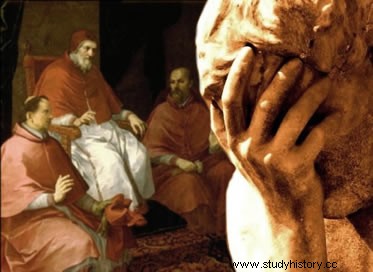
By Rainer Sousa
In the process of consolidation of the Catholic Church, we observed that the imposition of dogmas and hierarchical rigidity were fundamental elements in the organization of this institution. In addition to rules and positions, other actions were of great importance for this millenary religion to achieve stability. Among many others, excommunication played an essential role in the search for this principle of unity and preservation.
The term, of Latin origin, means “one who is outside the community”. For some debaters on the subject, excommunication should not be interpreted as a spiritual punishment that precedes divine judgment. That is, the excommunicated is not someone previously condemned to hell. According to the Council of Nicaea, of 325, the excommunicated only ceases to receive the Catholic sacraments.
However, departing from its theoretical understanding and observing its practice, excommunication had other much broader and more severe destinations. In the first centuries of the Christian Era, excommunication was widely used to drive away Christian leaders who practiced or ignored some religious determination of the Church. Over time, it served as a criterion for other actions to be taken.
For a long time, no Englishman who was excommunicated could bring any kind of lawsuit. Already in the Kingdom of the Franks, the monarch Pepin, O Breve (714 - 768), ordered that all excluded were summarily expelled from the territory. In these cases, we observe that religious punishment ended up serving to strengthen the bonds between State and Church.
However, we can see that the Church also employed excommunication to challenge or limit the interests of various kings, particularly in the Middle Ages. In the Late Middle Ages, the Holy Roman Empire was the state in which these actions took place most frequently. The overwhelming influence of ecclesiastical influence, both in the religious and economic spheres, led Church leaders to determine the expulsion of Frederick II (1194 - 1250) and Louis IV (1282 - 1347).
In the 16th century we have the excommunication of famous religious leaders who did not agree with Catholic dogmas. Martin Luther and John Calvin, respective founders of Lutheranism and Calvinism, were expelled from the Church for preaching a Christian religiosity apart from the papal seal. In that same century, the British king Henry VIII was expelled for disrespecting the sacraments that determined the continuation of the marital union between the English king and the Infanta Catherine of Aragon.
In this day and age, excommunication has turned into an act of ideological implication. Discrimination and other ills formerly suffered by its exercise had their meaning reconfigured. In 1962, Cuban dictator Fidel Castro was expelled from the Catholic Church after leading the revolutionary process in his country. In the previous decade, President Juan Perón was also similarly penalized after decreeing the expulsion of two bishops who criticized his government.
Recently, Irish singer Sinéad O'Connor did everything she could to get church leaders to bestow this infamous honor on her. In the early 1990s, when she was performing on a famous American television show, she ended her performance by tearing up a photo of Pope John Paul II. However, the Catholic rebuke only came in 1999, when she received an ordination to occupy the position of priestess in the so-called Independent Catholic Church.
In Brazil, we have had two recent cases of excommunication that have received great recognition. The first of them happened in 1984, when the theologian and writer Leonardo Boff was almost expelled for defending the guidelines of the so-called Liberation Theology. In 2009, the Church caused huge controversy by excommunicating doctors and the mother who performed the abortion of twins on a nine-year-old girl raped by her stepfather.
